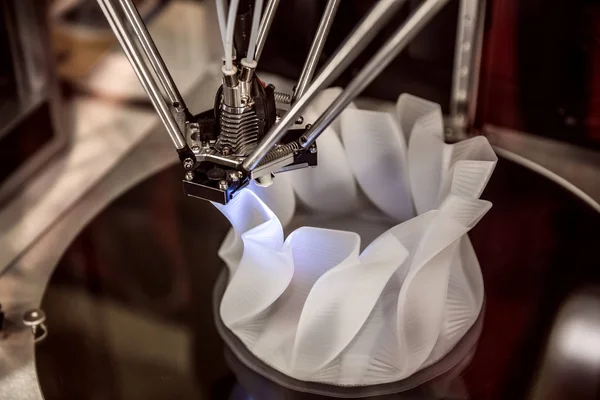
If you're interested in 3D printing and have already read our previous article on the key features of PETG vs. PLA, then you're just one step away from creating high-quality, durable 3D models that can be used in a variety of applications. If you haven't read it yet, be sure to explore our expertise after reading this article, which will help you become more informed in the revolutionary field of 3D printing.
As we mentioned in our last article, choosing the right material for a 3D model is the first step to success. The market offers a wide range of plastic types for 3D printing. But which ones are best? Let’s find out.
PETG Filament, ABS Filament, and ASA Filament
PETG, ABS, and ASA filaments are among the most popular choices for creating strong, functional models. In this article, we’ll go over their characteristics, benefits, and drawbacks to help you select the best material for your needs.
Key Characteristics of the Materials
PETG Filament
PETG is one of the most well-known materials, even for beginners, and for a good reason. It’s known for its high strength and resistance to chemicals. PETG is ideal for creating parts that must withstand moderate mechanical stress. PETG filament has excellent layer adhesion, making it suitable for larger, complex models. It’s commonly used for:
- Functional prototypes
- Electronics housings
- Containers
The density of PETG is around 1.27 g/cm³, making it a relatively lightweight yet durable material. At first glance, PETG density might seem identical to PETG filament, but there are some slight differences. Both offer good flexibility, and PETG density is well-suited for applications where minor deformation without breakage is necessary, such as brackets or protective covers. PETG density is also popular for items that need to withstand moderate heat, as it maintains its shape at temperatures up to 80°C. This material is an ideal choice for household items that may be exposed to heat, like lids or parts near heating elements.
ABS Filament
ABS filament is a classic in the world of 3D printing. Known for its strength, it offers exceptional resistance to mechanical stress, making it a great choice for prototyping and functional models where reliability and rigidity are crucial. ABS is often used for parts that need to withstand high loads, such as:
- Auto parts
- Protective tool covers
- Household appliances
The ABS density is approximately 1.04 g/cm³, making it lighter than PETG. Is ABS flexible? Yes, but within limits. It has moderate flexibility, allowing it to be used for parts that may need slight deformation under pressure, such as clips and fasteners. ABS 3D printing requires precise temperature control and a heated bed (around 100°C) to prevent warping.
Printing temperatures for ABS are typically between 220–250°C, and ABS-based materials demonstrate high heat resistance, withstanding temperatures up to 100°C. This heat resistance makes ABS suitable for parts exposed to heat, such as electronic components and under-the-hood automotive parts.
ASA Filament
ASA filament was developed as an alternative to ABS with enhanced properties for outdoor use. Its main advantage is its high resistance to UV radiation and external elements. The Sketchat team, for instance, has used ASA material multiple times to create outdoor objects and parts that need to withstand challenging weather conditions. Our clients have been satisfied with the results, so we’ve concluded that ASA material is an excellent choice in these cases. ASA plastic is ideal for manufacturing outdoor lighting fixtures, architectural models, automotive components, and garden accessories.
Key properties of ASA filament include:
- Excellent UV resistance
- High strength
- Stability against deformation
ASA is less prone to cracking under direct sunlight, making it a better option for creating durable items intended for outdoor use. ASA 3D printer filament retains its strength and shape even after long-term exposure to direct sunlight, which ensures the longevity of printed objects.
When printing with ASA, it’s essential to use an enclosed chamber to maintain a stable temperature and prevent warping. ASA 3D printing requires temperatures between 240 and 260°C, which makes it slightly more challenging to print than PETG.
Temperature Characteristics and Printing Requirements
Don't overlook printing temperatures, as they are crucial for each material — PETG filament, ABS filament, and ASA filament. Proper temperature control affects layer adhesion and resistance to warping. Let's take a closer look at the temperature requirements for these materials to help you select the optimal printing conditions and increase model strength. Here’s what you need to know for each:
PETG Filament
Printing Temperature: 220–250°C
PETG filament is highly resistant to warping, allowing you to print larger parts without an enclosed chamber. With the right temperature settings, PETG 3D printing can be done on a standard desktop 3D printer, as this material doesn’t shrink as much as ABS.
You can use this material for:
- Containers and boxes: Thanks to its chemical resistance, PETG is often used for containers that come into contact with liquids.
- Electronics enclosures: Moderate PETG heat resistance (up to 80°C) makes it a good choice for enclosures that protect electronics from dust and mild heat.
ABS Filament
Printing Temperature: 220–250°C, with a heated bed around 100°C
ABS plastic requires an enclosed chamber for printing due to its tendency to warp and shrink as it cools. ABS temperature resistance reaches up to 100°C, making it suitable for parts exposed to mechanical and thermal stress.
Use this material for:
- Industrial part prototypes: ABS's high strength and rigidity make it ideal for engineering prototypes.
- Automotive parts: Panels and small fasteners that need strength and durability.
ASA Filament
Printing Temperature: 240–260°C, with a heated bed and enclosed chamber required
As mentioned before, ASA material is especially UV-resistant, making it ideal for outdoor applications. It surpasses ABS in shape stability under changing external temperatures but also requires an enclosed chamber for printing.
With ASA Filament, you can create:
- Outdoor parts: Elements exposed to constant sunlight, such as garden accessories or solar panel mounts.
- Sports equipment parts: ASA 3D printer filament is perfect for durable accessories that withstand various weather conditions.
Temperature Requirements Comparison
To better visualize the differences, here’s a summary of key distinctions and temperature parameters:
PETG vs. ABS:
PETG is easier to print and less prone to warping, but it has lower heat resistance than ABS.
ABS is more challenging to print due to its tendency to shrink, but its high heat resistance makes it suitable for heated components.
ASA vs. ABS:
ASA stands out for its ability to withstand sun exposure and harsh weather conditions.
ABS, in contrast, is more suited for indoor use where there’s no direct sunlight.
Tips for Successful Printing
PETG: Print at a low speed to avoid sudden temperature changes. PETG is also easy to post-process; for PETG smoothing, light sanding can be effective.
ABS: Ensure good ventilation as printing ABS releases fumes that require air circulation. Keep the chamber temperature stable to reduce the risk of warping.
ASA: Choose ASA for models intended for outdoor use or bright sunlight. ASA requires a tightly enclosed chamber to maintain a stable temperature during printing.










